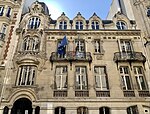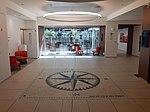Lavirotte Building
Art Nouveau apartment buildingsArt Nouveau architecture in ParisBuildings and structures in the 7th arrondissement of ParisHarv and Sfn no-target errors

The Lavirotte Building, an apartment building at 29 Avenue Rapp in the 7th arrondissement of Paris, France, was designed by the architect Jules Lavirotte and built between 1899 and 1901. The building is one of the best-known surviving examples of Art Nouveau architecture in Paris. The facade is lavishly decorated with sculpture and ceramic tiles made by the ceramics manufacturer Alexandre Bigot. Lavirotte was awarded the prize for the most original new facade in the 7th arrondissement in 1901.
Excerpt from the Wikipedia article Lavirotte Building (License: CC BY-SA 3.0, Authors, Images).Lavirotte Building
Avenue Rapp, Paris 7th Arrondissement (Paris)
Geographical coordinates (GPS) Address External links Nearby Places Show on map
Geographical coordinates (GPS)
| Latitude | Longitude |
|---|---|
| N 48.85912 ° | E 2.30091 ° |
Address
Immeuble Lavirotte
Avenue Rapp
75007 Paris, 7th Arrondissement (Paris)
Ile-de-France, France
Open on Google Maps










